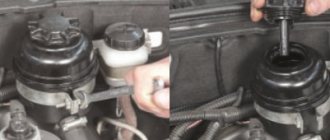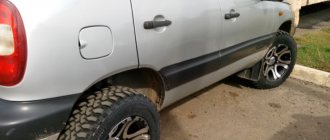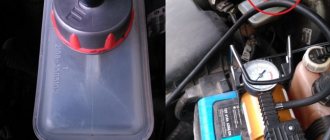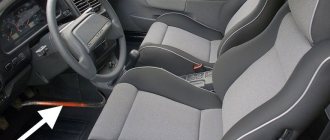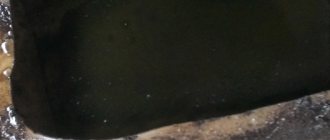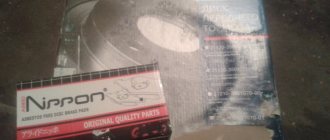How to bleed the brakes on a Chevrolet Niva yourself
Experienced car owners know that the brake fluid on a Chevrolet Niva needs to be changed every fifty thousand kilometers, but at least once every 2 years. So, if the car reacts poorly to pressing the brake pedal, this indicates that there is moisture or air in the system. Consequently, it is necessary to bleed the brake system in the Chevrolet Niva, completely replacing the brake fluid. Foreign elements appear there due to the natural chemical decomposition of some components of the brake fluid and the high temperature generated during braking. The following are considered signs of air penetration into the hydraulic drive:
Note. When pumping a hydraulic drive is directly related to the repair of one of the circuits, and the serviceability of the second circuit is known, it is permissible to pump only the circuit being repaired.
The process of bleeding the hydraulic drive in a Chevrolet Niva is identical to replacing the brake fluid. The only difference is that the condition for the end of pumping of the working cylinder is the end of the release of air from the tube, and not the appearance of new brake fluid.
Thus, the car owner needs to bleed the brakes when observing any of the following signs:
Bleeding the brakes of a Niva Chevrolet: step-by-step instructions
Air, compared to liquid, is more easily compressed, as a result of which the presence in the line rapidly reduces braking performance. In Chevrolet, the brake mechanism is equipped on a 2-circuit principle. The latter ensures reliability during depressurization. Thus, one circuit includes the working cylinders of the tires (right rear, left front), while the second circuit includes the left rear, right front. The pumping sequence involves bleeding air bubbles using a special fitting.
Signs of air penetration are as follows:
- increased pedal travel, softness appears when pressing the brake pedal;
- a smooth decrease in pedal travel and a simultaneous increase in rigidity when pressing the pedal (before pumping, depressurization must be identified and eliminated).
Activities must be carried out with a partner on an equipped area - an overpass or inspection hole. The tire casing bleeder fittings should be thoroughly cleaned of dirt. First, you have to get rid of the air in one brake circuit, starting with the rear right tire housing and ending with the left tire block at the front. Meanwhile, air should be removed when the rear wheels are loaded.
When bleeding the brakes in a Chevrolet Niva with a rear mounted section, it is worth loading the pressure lever of the brake located at the rear. Now you need to insert a screwdriver into the middle of the piston lever and the pressure regulator piston.
For work, prepare tools and consumables in advance:
- union (split) nut head for 10;
- union (split) nut head for 8;
- container for TJ (1-2 liter);
- rubber bulb;
- brake fluid;
- brake fitting;
- aerosol VD-40;
- rags;
- hose.
- Remove the dust cap from the fitting (to make it more convenient, it will fit to remove the rear tire).
- Wet the fitting with WD-40, then put a wrench on it and tighten the tightening bolt.
- Pull the rubber tube onto the fitting. Then lower its end into the prepared container, partially filled with TJ.
- Meanwhile, your partner needs to press the brake 3-4 times every 1-2 seconds, thus holding the pedal in the pressed position.
- Next, you need to take the head 8 and unscrew the fitting half or ¾ of a turn. At the same time, air bubbles, as well as some of the brake fluid, will escape into the container; the brake pedal will go to the floor.
- The next step is to tighten the fitting, after which the assistant can release the brake.
- Repeat the operation performed to bleed the Chevrolet. Perform the action until air bubbles stop coming out of the tube, but only TJ.
In the same way, you need to get rid of air using the upper fitting on the front tire on the left. To remove bubbles that form in another circuit, pump the tire in the following order: left - rear - front right tire.
Bleeding the brakes is especially necessary if any of the following symptoms occur:
- decreased braking performance;
- feeling of a cotton pedal;
- Each time you press the pedal, more force is required.
- Remember that hydraulic fluid is poisonous. If it gets on exposed skin, wash off immediately with plenty of water. If liquid suddenly gets into your eyes or is accidentally swallowed, call an ambulance immediately.
- Some types of liquid are flammable and can ignite if they come into contact with a hot substance or open flame. During work, it is better to play it safe, considering that any liquid is flammable, in order to react in time and take all precautions.
- Hydraulic fluid is considered aggressive towards plastic elements and paints. If liquid gets on the painted surface of the body or on plastic parts, it should be washed off immediately with plenty of water.
- Liquid has the ability to absorb moisture from the air, therefore it is hygroscopic. Excess moisture content reduces the boiling point to unacceptable parameters. This leads to an unsafe reduction in braking performance.
- Old liquid cannot be reused, because it may contain a lot of dirt and foreign particles. If you need to add or replace fluid, use only the recommended one.
How to bleed the brakes on a Chevrolet Niva yourself
An assistant is required to bleed the brakes.
Meanwhile, the choice of the sequence of bleeding the brake lines is not significantly important, since each caliper has its own connection to the main cylinder.
The car must be placed on a level surface, in first or reverse gear. Then it is advisable to place wheel chocks or a device made of boards under the wheels. Next, you need to check the brake fluid level in the cylinder reservoir, which is located under the hood (between the windshield and the air filter housing). After pumping out the old fluid from the tank, add fluid to the max mark on the tank. The preparatory activities have been completed, you can proceed directly to work.
It is not so easy to determine at random when a complete replacement of the brake fluid on a Chevrolet Niva has been carried out. It’s appropriate to proceed from the following volumes: if the car has ABS, you will need 0.5 liters for each caliper; without ABS, 0.4 liters is enough. Such figures are given with a slight margin so that the replacement is carried out efficiently and the conditions for the new fluid replacement are standard.
Source
Replacing brake fluid
If a replacement is needed, then you should study the structure of the brake system of your vehicle. Changing ABS brake fluid is very different.
Suppose without an ABC or a hydraulic accumulator, the pump and the ABC hydraulic valve block are located in one unit, then you can replace the fluid with your own hands. With integral ABC, it would be more correct to go to a service station.
Work must be carried out on each circuit of the brake system. The tools you will need are an empty bottle and a flexible hose. Additionally, you need to have a set of keys to work.
It all starts with the wheel that is furthest from the brake cylinder. First you need to drain the fluid from the brake reservoir and pour new one into it. Next, unscrew the fittings on each brake cylinder and wait until the old brake fluid drains out.
When a new one starts to leak, tighten the fitting. If the car has a diagonal system of contours, the process must begin with the right rear wheel, then the left front, then the rear left, and finally the front right.
With a parallel circuit, the sequence is:
Replacement must be carried out on removed wheels. If there is a hole, the work will be much easier. As a last resort, you can do all this with a jack, removing the wheels one by one.
At the same time, you can visually check the condition of the car, check the suspension elements and shock absorbers.
Be sure to bleed the brakes after all work. Look in the reservoir; you may need to add new fluid.
It is necessary to check the effectiveness of the brakes after replacing the brake fluid. We carry out the test on a dry road at various speeds. The car should stop smoothly and maintain directional stability. Have a good trip and no breakdowns.
Sources
When is it necessary to bleed the brakes?
The first of these is that the drive pipelines are exposed to negative environmental influences. The rear brake pipelines on VAZs are made of soft metals (copper, brass) and they pass under the bottom of the car. Oxidation processes and possible shock loads during operation can cause cracks or breakdowns in the pipeline.
The second reason why there may be air in the system is scheduled maintenance of the brake system. The fluid used in the drive has its own resource, so it must be replaced periodically. It is during the replacement process that air gets inside the system. It can also appear in the system after repair of mechanisms, for example, during the replacement of pads. Therefore, it is imperative to bleed the brakes after replacing the pads.
But on VAZ cars it is possible to remove air bubbles by pumping - a process in which air is expelled from the liquid. For this purpose, special fittings are provided for the design of the brake mechanisms.
It is not difficult to identify that the system requires bleeding - the failure of the pedal, the ease of pressing it and a decrease in the effectiveness of the brakes, up to their complete absence, indicate that the system is airy.
But before you start pumping, you should carefully inspect all pipelines and components of the system for leaks, as well as the amount of liquid in the tank. If traces of leakage are detected, the malfunction should be eliminated by repair using repair kits (main and working brake cylinders), replacing the damaged section of the system (pipelines), and after replacement, carry out bleeding. If air has entered the system due to a lack of fluid, it must first be replenished to the level.
Design of the working hydraulic system
In order to increase the reliability and safety of control, the hydraulic brake system of the Chevrolet Niva is built according to a dual-circuit diagonal design. The first hydraulic drive circuit drives the front right and rear left wheels, and the second drive drives the front left and rear right wheels. Thus, controllability is maintained in the event of failure of one of the hydraulic drive circuits. The hydraulic braking system includes:
Also interesting: How to bleed the brakes on a Chevrolet Niva correctly
Alternative way
How to bleed the clutch in an urban field video
This method is suitable when it is not possible to use the help of a partner. To do this, you will need to create excess pressure in the system using a simple bladder or spare tire. You'll have to be Kulibin a little to make an adapter between the chamber fittings and on the expansion tank cap (you need to use a spare cap).
Also interesting: How to turn off the car alarm completely
The essence of the procedure is the same as in the first option. You should unscrew the bleeder fittings one by one to get rid of excess air. Experts recommend carefully monitoring the fluid level in the tank and, if necessary, adding it to the required volume.
Brake fluid Niva Chevrolet, choice
Let's take the following fact as an axiom - almost NONE of the leading manufacturers of pads or brake components make their own brake fluid. It is made either by chemical concerns or manufacturers of auto chemicals and oils. Example. Everything that is in jars of the TRW, BMW, ATE brands is made by manufacturers ROWE, BASF, Pentosin, ELF-TOTAL. Therefore, when I selected suppliers, I was guided by the following thought. A well-known company that deals with brake systems simply will not disgrace itself and sell a low-quality product in its own name. That's why I settled on Bosch, TRW, Brembo products. To fully pump the system of our car, 1 liter of product is enough. There is still some left for refilling.
Purpose and operation of the pressure regulator
The pressure regulator (“sorcerer”) is designed to prevent the car from skidding during sudden braking. This is achieved due to the fact that the rear wheels begin to brake after the front ones. The time delay is provided by the regulator lever, which, when the car brakes sharply (the nose drops and the rear rises), pulls the piston in the regulator cylinder and closes the fluid supply channel to the working cylinders of the rear wheels.
In this case, the rear brakes do not work and the wheels spin until the rear of the car drops back. Thus, the “sorcerer” automatically regulates the fluid pressure in the rear cylinder path in inverse proportion to the load on the rear axle. In addition, it increases the braking efficiency of an empty vehicle when the load on the front axle is higher than on the rear.
This work must be carried out at every maintenance and after repair of the rear suspension.
Algorithm of actions
1. Remove the dust cap from the fitting (for convenience, you can first remove the wheel).
2. Moisten the fitting with WD-40, put a wrench on it and tighten the tightening bolt. 3. Place the rubber hose onto the fitting, and lower its other end into a container with brake fluid.
4. The assistant in the cabin slowly works the brake pedal until significant resistance appears. After that, he fixes the pedal pressed. 5. Turn the key in the unscrewing direction one turn. The liquid along with the air will escape into the vessel, but this will prevent a new portion of it from entering the system. The pedal will go down.
6. Tighten the fitting. 7. Repeat these steps until bubbles stop coming out. 8. Move to the next cylinder.
Important points
Work must be carried out only after the liquid leak has been eliminated, if this has not been preceded by repairs. After repairing the brake system, bleeding will only be necessary when depressurizing. For example, after replacing the brake pads, there will be no air in the system.
Brake fluid selection
All brake fluids except DOT 5 use polyethylene glycol in combination with boric acid polyesters as a base, while DOT 5 uses silicone as a base. Brake fluids DOT 3, DOT 4 and DOT 5.1 have the same base and can be interchanged without any problems, at least within the same manufacturer.
Some manufacturers use polyalkylene glycol as a base for the production of DOT 3 (and possibly other grades). Information on the incompatibility of liquids based on polyethylene glycol and polyalkylene glycol could not be found anywhere, and knowledge of chemistry as a first approximation allows us to state that such a mixture will work no worse than the original components.
It should also be separately mentioned that some brake fluids are designed to work in the braking systems of cars with ABS (anti-lock braking system), most often they are marked with the addition of the designation “ABS”, for example DOT 5.1/ABS, or this is indicated separately on the packaging.
You should not mix brake fluids, even of the same class, if one of them is designed for ABS and the other is not, i.e. mix, for example, DOT 5.1 with DOT 5.1/ABS, because these fluids have slightly different chemical compositions of additives to reduce aeration (prevent the formation of bubbles) in the ABS system and there is no guarantee that as a result you will have a brake fluid that is chemically and physically stable system.
If you have a car with ABS, then you cannot use DOT not designed for ABS or even just add it to another DOT for ABS, which is understandable. If we are talking about a bicycle and hydraulic bicycle brakes, then you can use any DOT, rated for ABS or not, preferably without mixing them.
When glycol-based fluids (DOT 3, DOT 4 or DOT 5.1) are mixed with silicone-based DOT 5 fluid, a chemical reaction occurs resulting in a compound that does not meet any brake fluid requirements and is aggressive to the seal material.
Do not mix DOT 3, DOT 4 or DOT 5.1 with DOT 5 silicone fluid! A complete replacement of glycol brake fluid with silicone is possible (DOT 3, 4, 5.1 to DOT 5), but this requires first cleaning and thoroughly drying the entire brake system of old brake fluid. At the same time, there is no guarantee that the material of the brake system seals will be resistant to silicone fluid, although the chances of damage to the seals by silicone fluid are quite small, because Silicone based fluid is not as aggressive as glycol based DOT. The advantages of such a replacement in the case of a bicycle are extremely unclear.
Replacing silicone brake fluid with glycol is practically impossible (DOT 5 to DOT 3, 4 or 5.1), no matter how much you flush the entire system beforehand, because glycol DOT is very aggressive and if the brake system elements were not originally designed for it, then most likely In all, the brake system seals will be destroyed. https://www.drive2.com/l/457842415315760117/
How to Bleed Brakes (3 Main Mistakes in Bleeding Brakes)
Knowing how to bleed brakes will be useful to any driver, since the procedure is not very complicated, and it must be performed after many manipulations related to the brake system. So why waste extra money once again by sending your car for service when you can pump the brakes alone?
By following the instructions and avoiding the mistakes described below, it is quite possible to remove the air from the brakes yourself, with or without ABS. Bleeding brakes with ABS is by no means more difficult, but still it is a separate topic worthy of its own article.
It is only worth noting that if there is an anti-lock braking system with ESP and SBC modules, then the path lies with a service that has the necessary equipment.
You can pump the brakes yourself, or you can have an assistant, whose task is to press the brake pedal on command. The procedure for bleeding the brakes should be found in the manual for a specific car.
If the diagram is not indicated, then bleeding is done in the form of the letter Z. This means that you need to pump in this order: right rear - left rear - right front - left front wheel.
To bleed the brakes, you will need a brake fluid container and a clear rubber hose.
First you need to get convenient access to the brake system bleeder fittings. To do this, you can put the car on a lift or platform and remove all the wheels. Don’t forget to clean the fittings near each wheel from dirt and pour a little “brake fluid” into the prepared container.
Instructions:
- Pour new brake fluid into the master cylinder reservoir.
- Connect the hose to the fitting, and lower the other end into a container with brake fluid.
- Command your assistant to press the pedal several times and hold it depressed until the fluid flows.
- Unscrew the fitting and the liquid will flow into the container you prepared. Carefully monitor the fluid level in the tank and add as necessary.
- Repeat the previous 2 steps until the brake fluid comes out clean without air bubbles, and tighten the fitting.
- Repeat the same procedure on the remaining wheels.
Bleeder fitting on the brake caliper. A hose is put on it
The brakes are bled when it is necessary to remove air from the brake system. This often happens when replacing brake fluid, which is done approximately every 50-60 thousand km. mileage or once every 2 years.
It is also necessary to bleed the brakes after repairing the brake system: replacing the master cylinder or vacuum brake booster. The need for bleeding also arises when depressurization occurs due to damage to the hoses, or when the liquid in the expansion tank drops below the minimum mark.
The pedal will indicate that you need to bleed the brakes - it will become soft and begin to sink. And the brakes themselves will become more sluggish. However, this could also indicate a more serious problem with the brake rotor or pads. So, if bleeding does not help, perhaps you should still contact a specialist - brakes are no joke!
How to pump the brakes with a partner has already been described above. What to do if there is no such thing nearby, but you need to bleed the brakes? You can get out of this situation in several ways:
- You can bleed the brakes alone if you have a gas stop. The meaning is the same as when pumping with an assistant, only instead of him the gas stop will press on the pedal. Therefore, you need to press the pedal several times, keep it pressed, set the stop and begin to bleed the brake fluid. When the fluid begins to flow, the stop will begin to push the pedal to the floor to the limit.
- bleeding the brakes with a syringe. You need to hermetically embed the syringe into exactly the same lid as on the tank. Then, having first filled the syringe with brake fluid, replace the regular cap with this device, unscrew the fitting, place a container and apply pressure with the syringe.
- another method with a modified lid. You need to insert a car nipple into a cap similar to the one installed on the tank. Then put the lid with the nipple on the tank, then put one end of the hose with a connection clamp on the lid, and the other on the spare chamber, inflated to no more than 1 atmosphere. Open the fitting and bleed out the liquid with air bubbles.
READ MORE: How to get a certificate of non-deprivation of rights in public services
Replacing brake fluid and bleeding brakes
Bleeding brakes with a homemade device
DIY brake bleeding device
These are the main ways to bleed brakes without an assistant, but many drivers have their own methods, which, however, are not very different from the above.
Before you start bleeding your brakes, it's worth considering three common mistakes that are made when doing this. Therefore you CANNOT:
- Mix different brake fluids. If you mix mineral brake fluid with glycol, it will damage the rubber cuffs of the hydraulic drive and clog the system with clots. It is also not recommended to mix liquids of different classes (DOT 3, DOT4, DOT5), since they have different boiling points and this will reduce their characteristics.
- Allow the brake fluid level to drop significantly. If you do not monitor the brake fluid level in the reservoir and it drops below the minimum level, air will enter the brake system.
- Create high pressure in the brake reservoir. When pumping the brakes yourself, do not overdo the pressure created in the reservoir, otherwise it may rupture. Recommended pressure is 0.8 atmospheres.
to our channel in Yandex.Zen
Even more useful tips in a convenient format
Subscribe
Did not find an answer to your question?
Required Tools
In order to change the brake fluid on a Chevrolet Niva, you need the tools from the table below.
Table - List of tools required to change brake fluid
| Tools | Note |
| Spanner | "at 8" |
| Transparent hose | Up to a meter long |
| Rags | To clean dirt |
| Syringe | Can be replaced with a rubber bulb |
| Tara | Can be replaced with a rubber bulb |
To carry out work, access from the bottom is required. Therefore, an inspection hole or overpass will be required. It is more convenient to replace the vehicle with a partner, but there are ways to carry out the task alone.
Replacing brake fluid, checking the level, topping up
| Replace the brake fluid in the hydraulic brakes every two years, regardless of the vehicle's mileage. |
| Before replacing the brake fluid, check the tightness of the hydraulic drive (see here) and eliminate any malfunctions. |
| You will need: an “8” wrench, brake fluid, a rubber or transparent hose, a transparent container. |
What brake fluid should I fill and how much?
Brake fluid type DOT-4 SAE J 1703, FMSS116. "Tom" or "Rosa" (not lower than DOT-4)
Total volume: 0.5 l .
Checking the level and adding brake fluid
| When the brake fluid level in the reservoir drops below the “MIN” mark, the warning lamp in the instrument cluster lights up red. We recommend checking the level before each trip and, if necessary, adding fluid to the tank without waiting for the warning light to come on: this operation is best carried out in advance. If you have to add brake fluid to the reservoir quite often, immediately contact a specialist or fix the problem yourself. |
| You will need: brake fluid, a clean rag. |
| The reservoir is installed on the master cylinder of the brake system on the left side of the engine compartment near the bulkhead. |
Bleeding the hydraulic brake system of Chevrolet Niva
Tools:
- Split spanner 10 mm
- Split spanner 8 mm
- Rubber bulb
- Capacity for brake fluid 1-2 l.
Parts and consumables:
- Brake fluid
- Rags
- Aerosol lubricant type WD-40
- Brake fitting
- Bleeding hose
Notes:
Bleeding the brakes is necessary when replacing brake fluid, as well as to remove air that has entered the hydraulic drive during the repair or replacement of individual components of the brake system. Air trapped in the hydraulic drive causes an increase in the free play of the brake pedal (the pedal becomes “soft”) and significantly reduces the effectiveness of the brakes.
Signs of air getting into the hydraulic drive are:
– when you press the pedal once – the pedal travel increases, its “softness”;
– with repeated pressing of the pedal – a gradual decrease in the pedal stroke with a simultaneous increase in its “hardness”. Before bleeding the hydraulic drive, it is necessary to identify and eliminate the cause of depressurization.
We carry out the work with an assistant on an inspection ditch or overpass. Thoroughly clean the wheel cylinder bleeder fittings from dirt. We remove air first from one brake circuit, starting from the wheel cylinder of the right rear wheel and ending with the cylinder block of the left front wheel. We remove air with the rear wheels loaded.
When bleeding the brakes on a car with the rear part suspended (for example, on a lift), it is necessary to load the rear brake pressure regulator, insert a screwdriver between the pressure regulator piston and the piston lever.
1. Remove the protective cap from the bleeder fitting of the wheel cylinder of the right rear wheel.
2. We put a hose on the head of the fitting, lowering its free end into a vessel partially filled with brake fluid.
3. An assistant presses the brake pedal three to four times at intervals of 1-2 seconds and holds the pedal down. Using the “8” wrench, unscrew the bleeder fitting 1/2 - 3/4 turn. In this case, air and part of the brake fluid are forced into the vessel, and the pedal is lowered to the floor (air bubbles are clearly visible in the vessel with the liquid). We tighten the fitting and only after that the assistant can release the brake pedal. We repeat the bleeding operation until the release of air bubbles from the hose stops and only brake fluid comes out. In this case, air and part of the brake fluid are forced into the vessel, and the pedal is lowered to the floor (air bubbles are clearly visible in the vessel with the liquid). We tighten the fitting and only after that the assistant can release the brake pedal. We repeat the bleeding operation until the release of air bubbles from the hose stops and only brake fluid comes out.
4. Then we remove air from the cylinder block of the left front wheel.
5. Remove the protective cap from the lower bleeder fitting of the cylinder block of the left front wheel.
6. Having put a hose on the head of the fitting, we lower its free end into a container partially filled with brake fluid. We remove air through the lower fitting of the cylinder block.
7. In the same way, we remove air through the upper fitting of the cylinder block of the front left wheel.
8. To remove air from another circuit, we bleed in the sequence: left rear - right front wheel.
Brake pads for Chevrolet Niva
The front wheels of the Niva Chevrolet use disc brakes, and the rear wheels use drum brakes. Accordingly, the pads on them are different. Pads are the main working part of the brakes, which carry the most load and wear out the fastest. If the car is used intensively, the condition of the pads should be checked at least once every six months. Today there are many different domestic and foreign manufacturers of pads for Niva-Chevrolet cars.
They differ in price, material, service life. The so-called “Kevlar” pads from the Japanese company NIBK are considered the most effective and “cool”. They are made using modern nanotechnology from a compound that is equally effective in various operating modes. The advantages of this pad model include:
The only disadvantage of these pads is the high cost, but the price corresponds to the quality.
If you need information about replacing front pads, this is the place for you.
Brake fluid Chevrolet Niva
In accordance with the operating instructions, brake fluids that comply with the international safety class DOT-4 are used in the brake system of vehicles produced by the GM-AVTOVAZ JV. Table 13.6
Brake fluid
| Name | Manufacturer |
| "Rosa DOT-4" | OJSC "Caprolactam" |
| Spectrol Disc Brake fluid | NPF "Spektr-Auto" |
| Brake fluid DOT-4 | BP, UK |
| Brake fluid DOT-4 | STP |
Repairing auto parts yourself is a responsible task that should be taken as seriously as possible. Sometimes a faulty spare part takes the driver by surprise, forcing him to spend a lot of time and money searching for a good service station, but there is an alternative solution to the problem; this requires a small amount of knowledge and a set of tools.
When repairing Chevrolet Niva brake fluid, you need to be extremely careful and not neglect the little things. To get acquainted with the issue, car enthusiasts often use various Internet portals dedicated to auto parts. Some of them use narrowly focused forums. But, as a rule, only generalized information is provided there, which is known initially. Where can you find a reliable source that offers really useful things? Our portal is open for this 24 hours a day. Online mode allows us to help clients at any time convenient for them. Moreover, a mobile version has been developed that is available to everyone.
A detailed description of such a unit as Chevrolet Niva brake fluid has a good structure with thematic headings. In addition, there is always the opportunity to familiarize yourself with the intricacies of installation. There are often situations when a driver is confident in his abilities, but when he gets down to work, questions begin to arise. Thanks to our portal, such moments can be easily avoided. The site is a database that is updated regularly. By using it as a support during repair work, the car enthusiast receives a serious advantage. Each of the articles has reliable support, tested in practice.
In addition to the repair manual, the owner of a personal car will be able to prevent a lot of breakdowns that occur due to the human factor, thanks to the information located on the site. Users are presented with a lot of useful recommendations for proper operation, which will help significantly extend the life of the unit and avoid many negative consequences.
Online support is an excellent and most convenient way to obtain the necessary information. Another significant plus is that articles are written for people. We understand that the reader will do everything with his own hands, and we try to make it as convenient and efficient as possible. Use the resource at any time of the day and find the answer to any question you may have regarding cars.
↓ Comments ↓
1. Car structure
1.0 Car structure 1.1 General information about cars 1.2 Passport data 1.3 Car keys 1.4 Controls 1.5 Heating and ventilation 1.6 Doors 1.7 Seat belts 1.8 Adjusting the position of the front seats 1.9 Adjusting the steering wheel
2. Recommendations for use
2.0 Recommendations for operation 2.1 Safety rules and recommendations 2.2 Tools and accessories 2.3 Running in the car 2.4 Operating the car during the warranty period 2.5 Checking the car before leaving 2.6 Replacing the air filter entering the cabin 2.7 Using a jack 2.8 Towing the car
3. Problems along the way
3.0 Malfunctions along the way 3.1 The engine does not start 3.2 Malfunctions of the fuel injection system 3.3 No idle speed 3.4 Interruptions in engine operation 3.5 The car moves jerkily 3.6 The car accelerates poorly 3.7 The engine stalls while driving 3.8 The oil pressure has dropped
Advantages and disadvantages of the braking system
Reviews from car enthusiasts about the brake system on the Chevrolet Niva show that it is generally quite reliable and effective, fully consistent with the class of SUV cars. The advantage is ease of control, ease of maintenance, adjustment and replacement of parts. The disadvantages are due to the use of a pressure regulator, the operation of which in some cases can manifest itself in the form of uneven braking, the appearance of vibration when braking at certain speeds, and an increase in braking distance.
Effective brakes on the Chevrolet Niva, as the main condition for the safety and controllability of the car, help maintain the high popularity of this model for many years.
